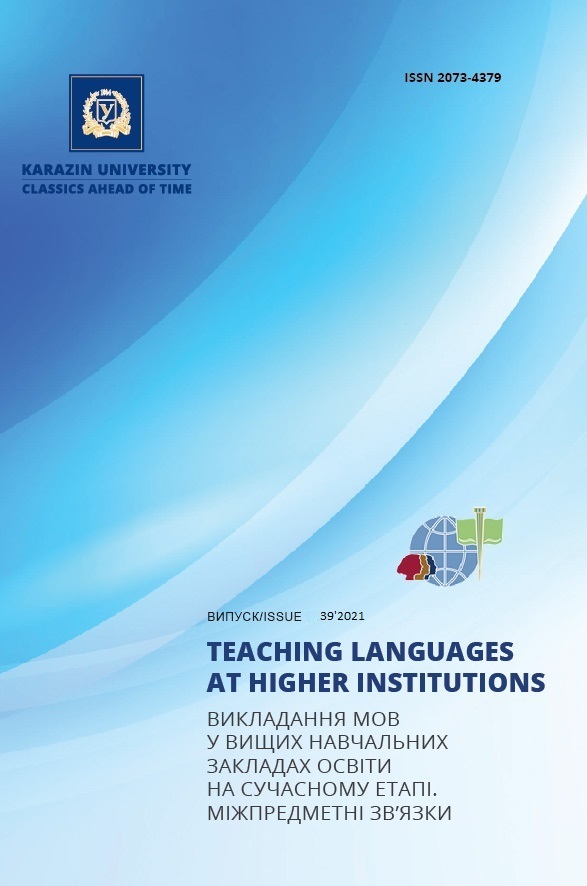“Flipped” method for teaching grammar of a foreign language at non-linguistic faculties
Abstract
The article deals with the theoretical description, analysis, and recommendations for the use of the “flipped” method for teaching foreign language grammar, which is introduced into the educational process of higher education institutions. The essence of the technology of flipped learning consists in the reorganization of the educational process – the home study of new material and classroom practice to reinforce it allows to make the learning process more effective. The “flipped” method has its advantages and disadvantages both for teachers and students. The advantages include intensification of the use of classroom time; proactivity, increased responsibility, and autonomy of students; conscious assimilation of educational material; creativity and critical thinking; taking into account the specifics of professionally oriented education, age characteristics and psychological needs of students; an opportunity to work on an individual schedule; archiving of materials. The “flipped” method encourages proactive schemes of teacher-student interaction. Experiments have shown a positive attitude of millennials to the inverted format after a period of adaptation and development. The level of acquisition of the new material depends on the internal motivation of the student. The classroom interactive and group-based tasks create and maintain external motivation.
Downloads
References
Gumynska, N. (2018) Indyvidualizaciya samostijnoyi roboty studentiv v procesi vprovadzhennya modeli zmishanogo navchannya v nemovnomu vuzi. [Individualization of students’ self-study in the process of introduction of blended learning in a non-linguistic university]. Vykorystannya modeli zmishanogo navchannya pry vykladanni inozemnyh mov [Blended learning usage in teaching foreign languages]. Kyiv: Kyiv National University of Trade and Economics, pp. 29–32 [in Ukrainian]. 2. Nikiforova, S.M., Pyvovarova, N.I. and Pyvovarova O.I. (2019). Evolyuciya metodiv navchannya inozemnoyi movy [Evolution of methods of teaching foreign languages]. Teoriya ta metodyka navchannya ta vyhovannya. [Theory and methods of education]. 46, pp. 70–91. Available at: http://journals.hnpu.edu.ua/ index.php/methodics/article/view/2529. [Accessed 17 July 2021] [in Ukrainian]. 3. Ryabukha, T.V., Gostishheva, N.O., Kulykova L.A. and Kharchenko T.I. (2020). “Perevernute navchannya” yak innovacijna tehnologiya vykladannya inozemnyh mov u vyshhij shkoli [Flipped learning as innovative technology in teaching English in higher educational institutions]. Pedagogika formuvannya tvorchoyi osobystosti u vyshhij i zagalnoosvitnij shkolah [Pedagogy of forming creativity and individuality in higher educational institutions and comprehensive secondary schools]. 72, 2, pp. 100–106 [in Ukrainian]. 4. Andujar, А., Salaberri-Ramiro, M.S. and Soledad Crúz Martínez, М. (2020). Integrating Flipped Foreign Language Learning through Mobile Devices: Technology Acceptance and Flipped Learning Experience. Sustainability. 12, 1110. Available at http://www.mdpi.com/journal/sustainability [Accessed 17 July 2021] [in English]. DOI: https://doi.org/10.3390/su12031110. 5. Basal, A. (2015). The implementation of flipped classroom in foreign language theaching. Turkish Online Journal of Distance Education-TOJDE October 2015. Volume 16, Number 4, Article 3, pp. 28–37 [in English]. 6. Bergmann, J. and Sams, A. (2012). Flip your classroom: Reach every student in every class every day. International Society for Technology in Education. Washington DC [in English]. 7. Bergmann, J. (2017). Solving the Homework Problem by Flipping the Learning. ASCD [in English]. 8. Chung, E. (2018) The Effects of Flipped Learning on Learning Motivation and Attitudes in a Class of College Physical Therapy Students. Journal of Problem-Based Learning. 1, pp. 29–36 [in English]. DOI: https://doi.org/10.24313/jpbl.2018.5.1.29. 9. Enfield, J. (2013). Looking at the impact of the flipped classroom model of instruction on undergraduate multimedia students at CSUN. Techtrends. 57 (6), pp. 14–27 [in English]. 10. Millard, E. (2012). 5 reasons flipped classrooms work: Turning lectures into homework to boost student engagement and increase technology-fueled creativity. University Business. December, pp. 26–29. Avavilable at http://www.universitybusiness.com/article/5-reasons-flipped-classrooms-work [Accessed 17 July 2021] [in English]. 11. Roehl, A., Reddy, S.L., and Shannon, G.J. (2013). The flipped classroom: An opportunity to engage millennial students through active learning strategies. Journal of Family and Consumer Sciences. 105 (2), pp. 44–49 [in English]. 12. Strayer, J. (2007). The effects of the classroom flip on the learning environment: A comparison of learning activity in a traditional classroom and a flip classroom that used an intelligent tutoring system. Doctor’s thesis. Available at https://etd.ohiolink.edu/ [Accessed 17 July 2021] [in English].

